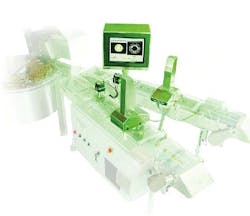- Cameras, usually color CCD devices similar to those in camcorders
- Frame grabbers, which digitize analog images and interface with bus structures
- PCs
- Software and fast data transfer
- Controls
Imaging functions may be further broken down into image acquisition, image processing, and feature extraction.
Machine vision performs four tasks very well: guidance, inspection, gauging, and identification, suiting them for packaging. However, with the right programming, vision systems can also pick out fill errors, detect smudges on ampoules, inspect lyophilization cakes for contaminants, and accept or reject solid materials based on average particle size. Some biotech companies have even used cameras to monitor froth and turbidity during fermentations.
But process applications lie at the fringes of Zuech’s definition because of the required human intervention. Besides, traditional measurements (temperature, pH, extent of reaction) are relatively straightforward and require no new thinking. With drug-makers just getting comfortable with conventional real-time process analytics, machine vision for process monitoring is probably a long way off, at least in North America.
For example, Japanese drug makers have embraced machine vision inspection of solid dosage forms, where their peers in the U.S. have not. Vision systems excel at for inspecting pills and tablets for defects, engravings, and overall integrity. About a half-dozen companies sell inspection equipment for this type of application to Japanese markets, but Nello Zuech says vendors can barely give their equipment away to U.S. pharmaceutical manufacturers.
Seidenader Markt (Schwaben, Germany) offers a barrier-enclosed inspection system with a throughput of 2,500 tablets per minute. The company also develops machine vision systems for ampoules, prefilled syringes, and infusion bottles plus ampoule cleaning/drying machines and capsule polishers. The InspectoRx tablet/capsule inspection system from American SensoRx (Glen Rock, N.J.) accepts or rejects solid doses based on integrity, color, shape, and presence of foreign object contamination. Other solid dose inspection vendors include Driam USA (Spartanburg, S.C.), AC Compacting (North Brunswick, N.J.), and Japan’s Kanebo. A few blister-pack equipment vendors, most notably Bosch and Uhlmann, integrate inspection systems on their machinery.
Eyes-in-a-Box
Machine vision can be deployed out of the box, built into a process, or custom-installed. Off-the-shelf apps like identification code recognition perform one task very well and do not require customization. “They’re about as close to a standard application as you can get,” notes Justin Testa, senior vice president for Identification Products at Cognex (Natick, Mass.).
Although high-end implementations tend to be custom-built, with unique lighting, integration, and object presentation, vision companies have been striving to develop more general-purpose products. “One goal is to make these deployments simpler and cheaper so users can be up and running quickly,” says Testa. Another is to provide products with the capability of vision systems and the ease of use of barcode readers.
Cognex, which sells sensors, components, and vision systems to several industries, offers In-Sight technology, which reads and verifies RSS (Reduced Space Symbology) codes on pharmaceutical packages for product identification and traceability. RSS codes, whose compactness allows them to go where no barcode has gone before, can uniquely identify unit doses, even individual tablets.






